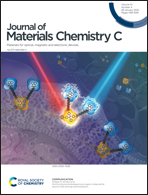Covalent organic polymers with solid-state dual-color fluorescence tunable by ultraviolet irradiation†‡
Abstract
An aldol condensation-based strategy is developed for preparing covalent organic polymers (COPs) with strong solution and solid-state dual fluorescence. Moreover, the fluorescence properties can be facilely tuned in two ways, according to the catalyst amount and ultraviolet (UV) irradiation. Single-color fluorescent COPs containing an allyl ketone (C![[double bond, length as m-dash]](https://www.rsc.org/images/entities/char_e001.gif) C–C
C–C![[double bond, length as m-dash]](https://www.rsc.org/images/entities/char_e001.gif) O) structure are prepared at low catalyst concentration. At high catalyst concentration, however, dual-color fluorescent COPs containing both allyl ketone and β-hydroxy ketone (HO–C–C–C
O) structure are prepared at low catalyst concentration. At high catalyst concentration, however, dual-color fluorescent COPs containing both allyl ketone and β-hydroxy ketone (HO–C–C–C![[double bond, length as m-dash]](https://www.rsc.org/images/entities/char_e001.gif) O) structures can be obtained. The fluorescence of the as-prepared dual-color COPs can be further tuned by UV irradiation, resulting in changes in the fluorescence spectrum and luminous color (e.g., from orange, pink, or white to green) of COPs. In this way, a single-source white light emitter is obtained and successfully used for a white light emitting diode (WLED). As-prepared dual-color COPs are also successfully used in other fields such as UV sensing and information encryption. The proposed strategy has good universal applicability and is also available for other synthetic monomer combinations, thus showing great promise in preparing dual-color COPs with strong and tunable solid fluorescence emission.
O) structures can be obtained. The fluorescence of the as-prepared dual-color COPs can be further tuned by UV irradiation, resulting in changes in the fluorescence spectrum and luminous color (e.g., from orange, pink, or white to green) of COPs. In this way, a single-source white light emitter is obtained and successfully used for a white light emitting diode (WLED). As-prepared dual-color COPs are also successfully used in other fields such as UV sensing and information encryption. The proposed strategy has good universal applicability and is also available for other synthetic monomer combinations, thus showing great promise in preparing dual-color COPs with strong and tunable solid fluorescence emission.



 Please wait while we load your content...
Please wait while we load your content...